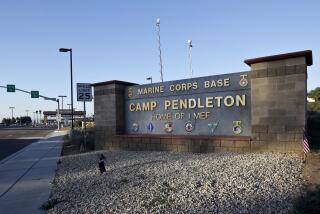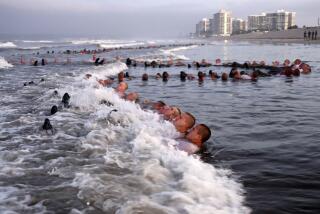Sub Mate Says Captain Rushed Procedure
PEARL HARBOR, Hawaii â The navigator on the submarine Greeneville testified Tuesday that the captain appeared too impatient to follow normal safety procedures in the moments before the sub collided with a Japanese fishing vessel during a rapid surfacing maneuver done to impress 16 civilian VIPs.
âHe was definitely going quickly; he wasnât wasting time,â Lt. Keith Sloan told a court of inquiry reviewing the Feb. 9 collision that killed nine aboard the trawler Ehime Maru.
Even while praising Cmdr. Scott D. Waddle, Sloan testified that Waddle tended to ignore junior officers and often wanted to push the sub faster and deeper than the executive officer thought prudent.
Sloanâs testimony is the first account by a member of the Greeneville crew detailing the leadership style of Waddle, one of the Navyâs top-rated submarine commanders before the tragedy nine miles off Diamond Head.
An initial investigation by the Navy has concluded that Waddle, behind schedule to get his civilian guests back to Honolulu, took several shortcuts. Also, a sonar technician allegedly failed to give the captain information about the dangerous proximity of the trawler.
The shortcuts ordered by Waddle allegedly included not allowing enough time for sonar and radar readings and only taking a brief look through the periscope before ordering the sub to dive and execute an âemergency blow.â
Sloan said Waddle undercut the officer of the deck, Lt. j.g. Michael Coen, by turning him into a âmouthpieceâ for issuing orders to the crew rather than asking for his judgment on whether the submarine was being operated safely during the surfacing maneuver, a complex and risky procedure.
Three admirals, with a Japanese admiral serving as advisor, will decide whether Waddle, Coen and the executive officer, Lt. Cmdr. Gerald K. Pfeifer, deserve to be punished, possibly court-martialed for negligence.
Sloan said he had spoken to Waddle on several occasions about his tendency to give specific orders to junior officers rather than bringing them into the decision-making process, as the Navy encourages. The Navy even trains junior officers in how to stand up to overbearing captains, officials said.
âI had expressed concern with the captain over this,â Sloan said. âHe basically told me he was happy the way he was doing it.â
Still, Sloan said he did not think Waddle was endangering the boat before the accident. Otherwise, he said, he would have spoken up.
The Navy on Monday announced tentative plans to hire a firm from the Netherlands to salvage the trawler from 2,000 feet of water and possibly retrieve the nine bodies. The effort would cost at least $40 million and take months to complete, officials said.
Sloan testified that Waddle and Pfeifer often disagreed with each other about how fast, deep and sharply the sub should be âdriven.â During the VIP cruise, Waddle ordered the sub to a depth of more than 800 feet, to the surprise of senior officers investigating the collision.
âSometimes the captain would get excited . . . . âWe can do this, this and this,â â Sloan said. âAnd the executive officer would say: âLetâs slow down and think about this.â â
Pfeiferâs attorney has indicated that his client felt Waddle was being unsafe but was reluctant to disagree with him in front of the civilians, who were part of the Navyâs Distinguished Visitors public relations program.
Also Tuesday, Capt. Robert L. Brandhuber, chief of staff for the Pacific Fleetâs top submarine admiral, testified that he also thought Waddle was moving too quickly in his periscope checks and had a âdebate with myselfâ about whether to overrule Waddle. He opted not to do so, he said, because he did not want to disagree with the captain in front of the visitors.
Brandhuber was aboard as an escort to the civilians. His son-in-law was the Greenevilleâs engineer.
In one of the more ironic aspects of the tragedy, Sloan testified that just minutes before the collision he had told Brandhuber about Waddleâs habit of ignoring junior officers, such as Coen, whom Sloan praised as âmethodicalâ and âby the book.â
Before the collision, Waddle and his boat were considered models of efficiency. In fact, an upcoming change of command ceremony for the admiralâs post was scheduled to take place on the Greeneville.
Just how critical the three admirals will be of Waddleâs conduct in the control room is unclear.
More to Read
Sign up for Essential California
The most important California stories and recommendations in your inbox every morning.
You may occasionally receive promotional content from the Los Angeles Times.










